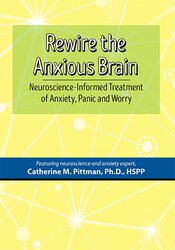
Get immediate lifetime access to this content by purchasing the digital seminar/online course instead that you can access using a variety of devices, and one CE certificate is included with purchase! Click the “Digital Seminar” or "Online Course" link below to learn more!
DVD Purchasers please note: In order to view the content, you will be required to have a DVD player or a DVD drive on your computer. Your CE is a separate fee.

Join neuroscience and anxiety expert, Dr. Catherine Pittman, and learn her keys for successful anxiety treatment. Dr. Pittman integrates brain-based strategies for calming the anxious mind with client communication techniques that motivate change in your clients. Catherine’s approach promotes adherence to treatment and strengthens the therapeutic alliance - which is essential when working with anxious, worried, traumatized, or obsessive clients.
Dr. Pittman will give you proven tools and techniques to:
Therapy is about change - it’s about creating a new self - and incorporating the concept of “rewiring the brain” is a potent method for stopping anxiety in its tracks.
| File type | File name | Number of pages | |
|---|---|---|---|
| Manual (1.97 MB) | 60 Pages | Available after Purchase |
Access never expires for this product.
Use Neuroscience in the Treatment of Anxiety
Enhancing Engagement in Treatment
Neuroplasticity
Identify Two Neural Pathways to Anxiety
Client-Friendly Explanations
Neuroplasticity in the Amygdala (Essential for all Anxiety Disorders, PTSD, OCD, Depression)
Neuroplasticity in the Cortex (Essential for GAD, SAD, OCD, PTSD, Depression)
Neuroplasticity and Medications for Anxiety Disorders, OCD, PTSD, Depression
Moving Beyond Diagnostic Categories to Focus on Anxiety Pathways
| 5 |
|
| 4 |
|
| 3 |
|
| 2 |
|
| 1 |
|
Satisfaction Guarantee
Your satisfaction is our goal and our guarantee. Concerns should be addressed to: PO Box 1000, Eau Claire, WI 54702-1000 or call 1-800-844-8260.
ADA Needs
We would be happy to accommodate your ADA needs; please call our Customer Service Department for more information at 1-800-844-8260.
PESI Mobile App
Access CE trainings on your phone or tablet through our free mobile app. Choose video or audio-only versions of online courses from the world’s best instructors, and complete your CE requirements anywhere, anytime, at your own pace.
Please wait ...